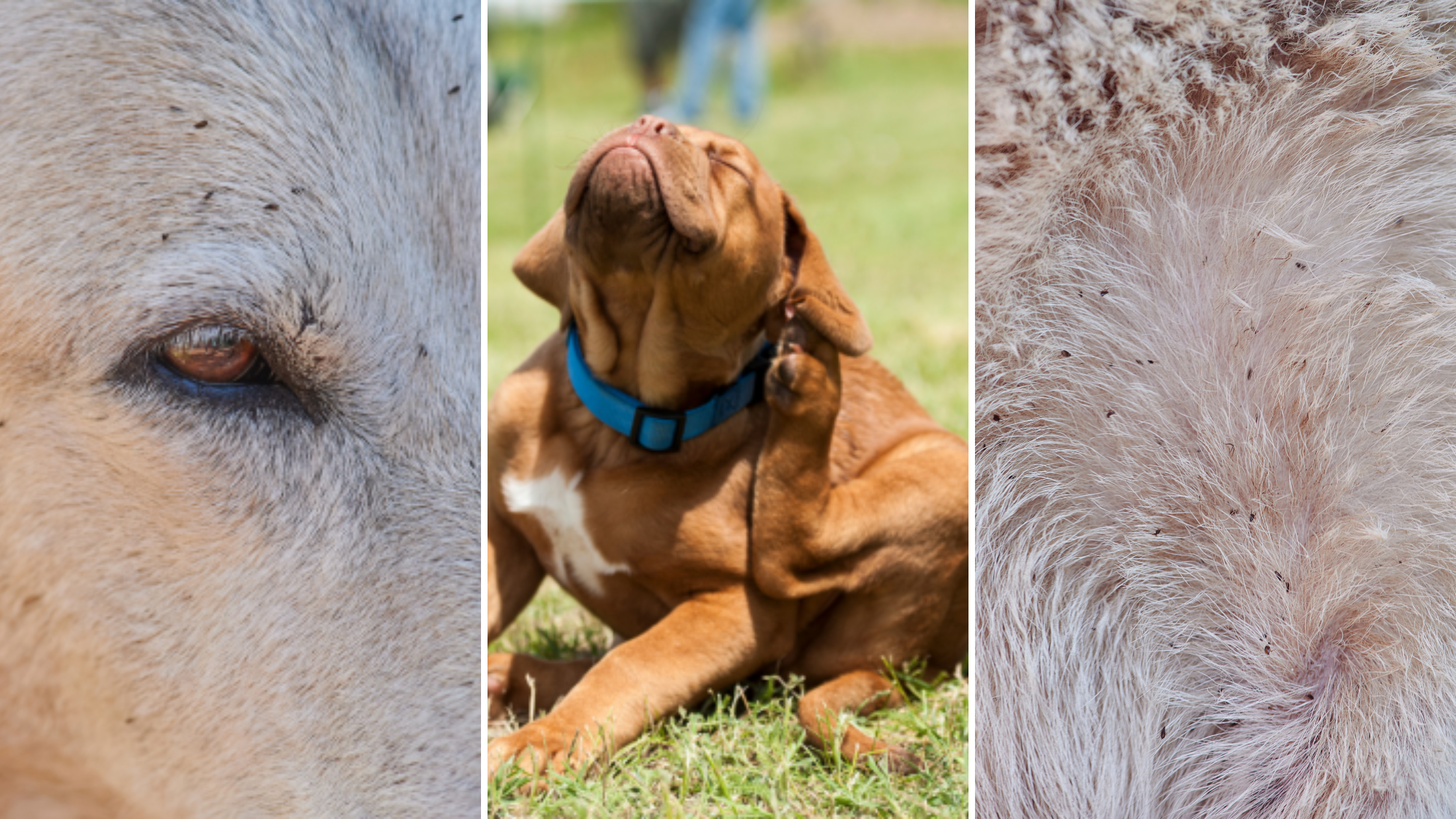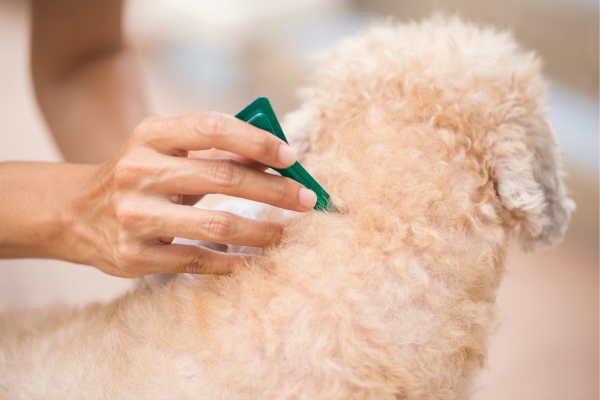Fleas: What you need to know and how to treat them?
Learn how to spot the signs of fleas, understand the health risks, and discover the best treatments to protect your dog and home from infestations.
Fleas are one of the most common pests that affect dogs, and there has been a large increase in dog owners and pet professionals reporting cases of fleas.
Fleas are not only a nuisance but can also lead to a range of health issues for your dog if left untreated. In this blog post, we’ll dive into the lifecycle of fleas, how to spot an infestation, the health risks, and how to treat fleas effectively.
Understanding the Flea Lifecycle:
Fleas go through four stages in their lifecycle:
- Eggs: Female fleas lay eggs on the dog’s fur, but these eggs often fall off and land in the environment (your home, garden etc.).
- Larvae: Once the eggs hatch, flea larvae emerge and begin feeding on organic matter, such as flea faeces (which is mainly undigested blood).
- Pupae: After several molts, the larvae enter the pupal stage, which is the most resistant stage of the flea. The pupae can remain dormant for weeks or even months, waiting for a host to approach (e.g. your dog)
- Adults: Adult fleas emerge from the pupae when they detect a warm body nearby. They then jump onto the host to start feeding and reproducing, continuing the cycle.
Understanding this lifecycle is key to treating a flea infestation effectively. While adult fleas are easy to spot, it’s essential to target all stages of the lifecycle to prevent reinfestation.
Signs Your Dog Has Fleas
It’s not always easy to spot fleas on your dog, as they’re tiny and can be quick to hide in your pet’s fur. However, there are several tell-tale signs that your dog may be dealing with fleas:
- Constant Scratching and Biting: Fleas cause intense itching, and dogs will often scratch or bite at their skin to try to relieve the discomfort.
- Hair Loss or Bald Patches: Excessive scratching or chewing can cause hair loss or bald patches, especially around the tail, belly, and back.
- Flea Dirt: This looks like small black specks that resemble pepper. Flea dirt is actually flea faeces, and if you place it on a damp paper towel, it will turn red (because it’s digested blood).
- Red, Inflamed Skin: Flea bites can cause allergic reactions in some dogs, leading to red, irritated, or even infected skin.
- Visible Fleas: While adult fleas are small and fast, you may be able to spot them moving in your dog’s fur, particularly around the base of the tail, neck, and groin areas.

Health Risks of Fleas for Dogs
Fleas are more than just an inconvenience. If left untreated, flea infestations can lead to serious health issues for your dog, including:
- Flea Allergy Dermatitis (FAD): Some dogs are allergic to flea saliva. Even a single bite can trigger severe itching, redness, swelling, and skin infections.
- Anaemia: Heavy flea infestations can cause blood loss, leading to anaemia, especially in puppies or small dogs. Signs of anaemia include weakness, lethargy, pale gums, and rapid breathing.
- Tapeworms: Fleas can carry tapeworm larvae, and if your dog swallows a flea while grooming, it can become infected with tapeworms.
- Secondary Infections: Constant scratching and biting can lead to open wounds that are vulnerable to bacterial infections.
How to Treat Fleas and How Often?
Treating fleas requires a multi-step approach to ensure you get rid of both the adult fleas and the eggs/larvae in your home environment. Here’s a step-by-step guide:
1. Flea Treatment for Your Dog:
- Flea Spot-on Treatments: These are applied to your dog’s skin, usually between the shoulder blades, and provide long-lasting protection (typically for 1-3 months).
- Oral Flea Medications: These are chewable tablets like Capstar or Comfortis, which kill adult fleas quickly. They usually need to be administered monthly.
- Flea Collars: These can be an effective preventive measure but should be used in combination with other treatments.
- Flea Shampoos: While shampoos can help kill fleas on contact, they don't offer long-term protection, so they should be used in conjunction with other treatments.
2. How Often to Treat:
- Spot-on treatments: Typically every 4 weeks.
- Oral medications: Prescribed by vet and directed by your vet.
- Flea collars: Generally last up to 8 months, but always check the product’s guidelines.
Be sure to follow the manufacturer’s guidelines and consult your vet for recommendations specific to your dog’s age, size, and health condition.

What to Do If My Dog Has Fleas?
If you suspect your dog has fleas, acting quickly is key to preventing the infestation from spreading. Here’s what you should do:
- Treat Your Dog: Start by applying a flea treatment (spot-on, oral medication, or shampoo) according to the instructions. Consult your vet if you're unsure about which treatment is best for your dog.
- Treat Your Home: Fleas don’t just live on your dog. They lay eggs that fall off and hatch in your home. To prevent reinfestation, you’ll need to fumigate your house:
- Vacuum Regularly: Thoroughly vacuum your carpets, floors, furniture, and any other places your dog frequents. Dispose of the vacuum bag immediately to prevent flea eggs from hatching.
- Wash Bedding and Fabrics: Wash your dog’s bedding, toys, and any fabric your dog frequently comes into contact with in hot water.
- Flea Sprays or Foggers: Consider using a flea spray or fogger in your home to kill any remaining eggs or larvae. Make sure to follow safety instructions carefully.
- Treat Other Pets: If you have other pets, they may also be at risk of fleas. Make sure to treat all animals in your home to avoid cross-contamination.
- Prevention: After treating your dog, keep up with regular flea prevention treatments to avoid future infestations. This includes monthly flea preventatives and maintaining a clean environment.
Fleas can be a nuisance, but with the right treatment and preventive measures, you can protect your dog and home from these pesky parasites. If you're unsure about what flea treatments are best for your pet, always consult your vet for personalised professional advice. Regular checks for fleas, good hygiene practices, and timely treatment are your best defences against flea infestations.
If you notice signs of fleas, don't wait—act quickly to keep your dog healthy and comfortable!
